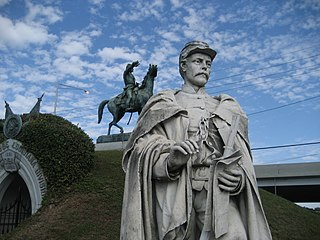
Alexander Doyle (1857–1922) was an American sculptor.

The Thomas A. Hendricks Monument is a public artwork by American artist Richard Henry Park and is located on the southeast corner of the Indiana Statehouse grounds in Indianapolis, Indiana. The monument is a tribute to Thomas A. Hendricks, the 21st Vice President of the United States. Hendricks was a former U.S. Representative and U.S. Senator from Indiana. He was the 16th Governor of Indiana and led the campaign to build the Indiana Statehouse.

The James Cardinal Gibbons Memorial Statue is a public artwork by Leo Lentelli, located at the Shrine of the Sacred Heart, 16th Street and Park Road Northwest, Washington, D.C.

Guglielmo Marconi is a public artwork by Attilio Piccirilli, located at the intersection of 16th and Lamont Streets, N.W., in the Mount Pleasant neighborhood of Washington, D.C., United States. It stands as a tribute to Italian inventor Guglielmo Marconi. It was paid for by public subscription and erected in 1941. The artwork was listed on both the District of Columbia Inventory of Historic Sites and the National Register of Historic Places in 2007. It is a contributing property in the Mount Pleasant Historic District. The monument was originally surveyed as part of the Smithsonian's Save Outdoor Sculpture! survey in 1994.
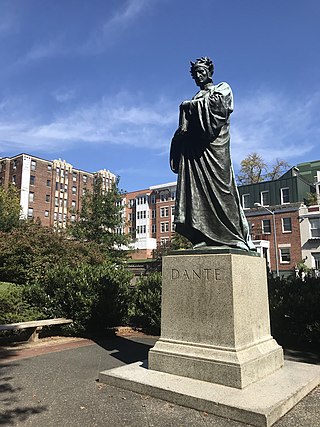
Dante Alighieri, is a public artwork by Italian artist Ettore Ximenes, located at Meridian Hill Park in Washington, D.C., United States. Dante Alighieri was originally surveyed as part of the Smithsonian Institution's Save Outdoor Sculpture! survey in 1994. The monument is a tribute to Italian poet Dante Alighieri.

The Luther Monument is a public artwork located at Luther Place Memorial Church in Washington, D.C., United States. The monument to Martin Luther, the theologian and Protestant Reformer, is a bronze full-length portrait. It is a copy of the statue created by Ernst Friedrich August Rietschel as part of the 1868 Luther Monument in Worms, Germany. The monument was originally surveyed as part of the Smithsonian's Save Outdoor Sculpture! survey in 1993.

Major General James B. McPherson is a public artwork by American artist Louis Rebisso, located at McPherson Square in Washington, D.C., United States. Major General James B. McPherson was originally surveyed as part of the Smithsonian's Save Outdoor Sculpture! survey in 1993. The monument is a bronze equestrian statue of Civil War hero James B. McPherson. The statue is a contributing monument to the Civil War Monuments in Washington, DC, of the National Register of Historic Places.

Christopher Columbus is a public artwork by Italian artist Enrico Vittori and located on the grounds of the Indiana Statehouse in Indianapolis, Indiana. The sculpture was installed on the southwest corner of the Indiana Statehouse lawn in 1920 as a gift from Italian immigrant communities in Indiana.

The George Gordon Meade Memorial, also known as the Meade Memorial or Major General George Gordon Meade, is a public artwork in Washington, D.C. honoring George Meade, a career military officer from Pennsylvania who is best known for defeating General Robert E. Lee at the Battle of Gettysburg. The monument is sited on the 300 block of Pennsylvania Avenue NW in front of the E. Barrett Prettyman United States Courthouse. It was originally located at Union Square, but was removed and placed in storage for fourteen years before being installed at its current location. The statue was sculpted by Charles Grafly, an educator and founder of the National Sculpture Society, and was a gift from the state of Pennsylvania. Prominent attendees at the dedication ceremony in 1927 included President Calvin Coolidge, Governor John Stuchell Fisher, Secretary of the Treasury Andrew W. Mellon, and Senator Simeon D. Fess.

John J. Pershing General of the Armies, is a public artwork by American artist Robert White, located at Pershing Park in Washington, D.C., United States. John J. Pershing General of the Armies was originally surveyed as part of the Smithsonian's Save Outdoor Sculpture! survey in 1994. The monument is a tribute to United States Army general John J. Pershing.
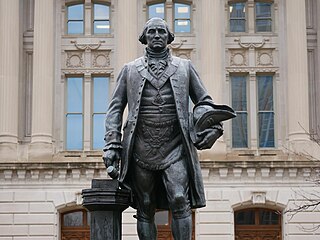
George Washington is a public artwork by American sculptor Donald De Lue, located on the grounds of the Indiana Statehouse, in Indianapolis, Indiana, United States. The bronze statue of George Washington that occupies the Indiana Statehouse south lawn is one of several copies of a 1959 original wax cast at the Modern Art Foundry in Long Island, New York.

Fortitude is a public artwork by the American artist James King, located in Fortitude Plaza at Howard University in Washington, D.C., United States. Fortitude was originally surveyed as part of the Smithsonian's Save Outdoor Sculpture! survey in 1993.
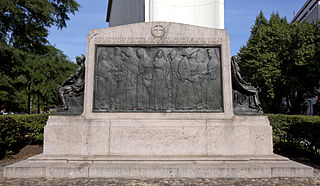
Nuns of the Battlefield is a public artwork made in 1924 by Irish artist Jerome Connor, located at the intersection of Rhode Island Avenue NW, M Street, and Connecticut Avenue NW, in Washington, D.C., United States. A tribute to the more than 600 nuns who nursed soldiers of both the Union Army and the Confederate States Army during the American Civil War, it is one of two monuments in the District that mark women's roles in the conflict. It is a contributing monument to the Civil War Monuments in Washington, D.C., listed on the National Register of Historic Places. In 1993, it was surveyed for the Smithsonian Institution's Save Outdoor Sculpture! program.

Rabboni is a public artwork by American artist Gutzon Borglum, located Rock Creek Cemetery in Washington, D.C., United States. Rabboni was surveyed as part of the Smithsonian Save Outdoor Sculpture! survey in 1993. It is a tribute to Charles Matthews Ffoulke, prominent Washington banker and tapestry collector.
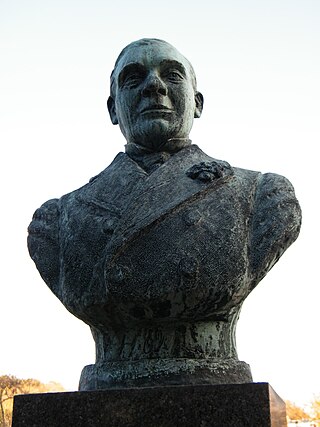
Edwin B. Hay is a public artwork by American artist Vinnie Ream, located at Rock Creek Cemetery in Washington, D.C., United States. "Edwin B. Hay" was surveyed as part of the Smithsonian's Save Outdoor Sculpture! program in 1993. It serves as the gravesite for the Hay family.

Thompson-Harding Monument is a public artwork by an unknown artist, located at Rock Creek Cemetery in Washington, D.C., United States. The monument was originally surveyed as part of the Smithsonian's Save Outdoor Sculpture! survey in 1993.

The Teresina Vasco Monument is a public artwork by Andrea Sichi, located at Glenwood Cemetery in Washington, D.C., United States. "Teresina Vasco Monument" was surveyed as part of the Smithsonian Save Outdoor Sculpture! survey in 1994. It serves as the final resting place for the young Teresina Vasco.

The Boy Scout Commemorative Tribute is a public artwork by American sculptor Donald De Lue, located on The Ellipse within The White House and President's Park in Washington, D.C., United States. The monument and fountain are maintained by the National Park Service. Sometimes referred to as the Boy Scout Memorial or Boy Scout Fountain, the Boy Scout Commemorative Tribute serves as a monument to the Boy Scouts of America.
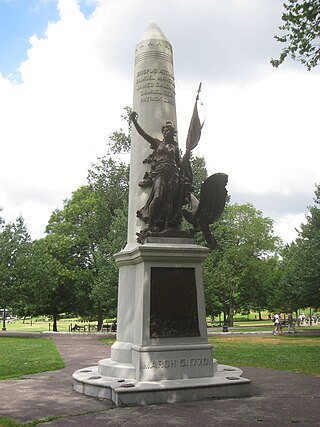
The Boston Massacre Monument, also known as the Crispus Attucks Monument and Victory, is an outdoor bronze memorial by Adolph Robert Kraus, installed in Boston Common, in Boston, Massachusetts, United States.






















